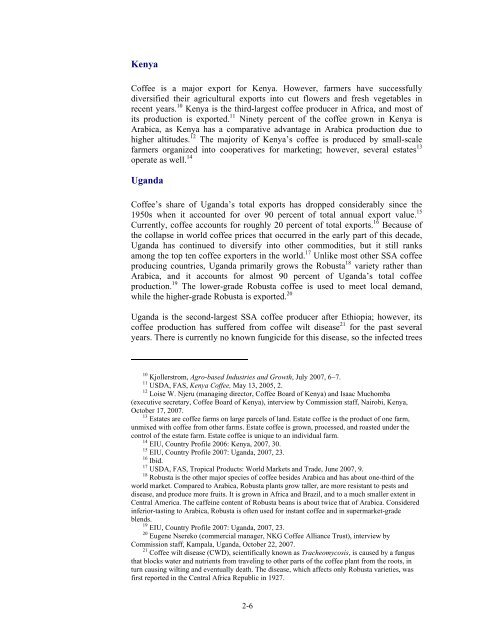Factors Affecting Trade Patterns of - United States International ...
Factors Affecting Trade Patterns of - United States International ...
Factors Affecting Trade Patterns of - United States International ...
Create successful ePaper yourself
Turn your PDF publications into a flip-book with our unique Google optimized e-Paper software.
Kenya<br />
C<strong>of</strong>fee is a major export for Kenya. However, farmers have successfully<br />
diversified their agricultural exports into cut flowers and fresh vegetables in<br />
recent years. 10 Kenya is the third-largest c<strong>of</strong>fee producer in Africa, and most <strong>of</strong><br />
its production is exported. 11 Ninety percent <strong>of</strong> the c<strong>of</strong>fee grown in Kenya is<br />
Arabica, as Kenya has a comparative advantage in Arabica production due to<br />
higher altitudes. 12 The majority <strong>of</strong> Kenya’s c<strong>of</strong>fee is produced by small-scale<br />
farmers organized into cooperatives for marketing; however, several estates 13<br />
operate as well. 14<br />
Uganda<br />
C<strong>of</strong>fee’s share <strong>of</strong> Uganda’s total exports has dropped considerably since the<br />
1950s when it accounted for over 90 percent <strong>of</strong> total annual export value. 15<br />
Currently, c<strong>of</strong>fee accounts for roughly 20 percent <strong>of</strong> total exports. 16 Because <strong>of</strong><br />
the collapse in world c<strong>of</strong>fee prices that occurred in the early part <strong>of</strong> this decade,<br />
Uganda has continued to diversify into other commodities, but it still ranks<br />
among the top ten c<strong>of</strong>fee exporters in the world. 17 Unlike most other SSA c<strong>of</strong>fee<br />
producing countries, Uganda primarily grows the Robusta 18 variety rather than<br />
Arabica, and it accounts for almost 90 percent <strong>of</strong> Uganda’s total c<strong>of</strong>fee<br />
production. 19 The lower-grade Robusta c<strong>of</strong>fee is used to meet local demand,<br />
while the higher-grade Robusta is exported. 20<br />
Uganda is the second-largest SSA c<strong>of</strong>fee producer after Ethiopia; however, its<br />
c<strong>of</strong>fee production has suffered from c<strong>of</strong>fee wilt disease 21 for the past several<br />
years. There is currently no known fungicide for this disease, so the infected trees<br />
10<br />
Kjollerstrom, Agro-based Industries and Growth, July 2007, 6−7.<br />
11<br />
USDA, FAS, Kenya C<strong>of</strong>fee, May 13, 2005, 2.<br />
12<br />
Loise W. Njeru (managing director, C<strong>of</strong>fee Board <strong>of</strong> Kenya) and Isaac Muchomba<br />
(executive secretary, C<strong>of</strong>fee Board <strong>of</strong> Kenya), interview by Commission staff, Nairobi, Kenya,<br />
October 17, 2007.<br />
13<br />
Estates are c<strong>of</strong>fee farms on large parcels <strong>of</strong> land. Estate c<strong>of</strong>fee is the product <strong>of</strong> one farm,<br />
unmixed with c<strong>of</strong>fee from other farms. Estate c<strong>of</strong>fee is grown, processed, and roasted under the<br />
control <strong>of</strong> the estate farm. Estate c<strong>of</strong>fee is unique to an individual farm.<br />
14<br />
EIU, Country Pr<strong>of</strong>ile 2006: Kenya, 2007, 30.<br />
15<br />
EIU, Country Pr<strong>of</strong>ile 2007: Uganda, 2007, 23.<br />
16<br />
Ibid.<br />
17<br />
USDA, FAS, Tropical Products: World Markets and <strong>Trade</strong>, June 2007, 9.<br />
18<br />
Robusta is the other major species <strong>of</strong> c<strong>of</strong>fee besides Arabica and has about one-third <strong>of</strong> the<br />
world market. Compared to Arabica, Robusta plants grow taller, are more resistant to pests and<br />
disease, and produce more fruits. It is grown in Africa and Brazil, and to a much smaller extent in<br />
Central America. The caffeine content <strong>of</strong> Robusta beans is about twice that <strong>of</strong> Arabica. Considered<br />
inferior-tasting to Arabica, Robusta is <strong>of</strong>ten used for instant c<strong>of</strong>fee and in supermarket-grade<br />
blends.<br />
19<br />
EIU, Country Pr<strong>of</strong>ile 2007: Uganda, 2007, 23.<br />
20<br />
Eugene Nsereko (commercial manager, NKG C<strong>of</strong>fee Alliance Trust), interview by<br />
Commission staff, Kampala, Uganda, October 22, 2007.<br />
21<br />
C<strong>of</strong>fee wilt disease (CWD), scientifically known as Tracheomycosis, is caused by a fungus<br />
that blocks water and nutrients from traveling to other parts <strong>of</strong> the c<strong>of</strong>fee plant from the roots, in<br />
turn causing wilting and eventually death. The disease, which affects only Robusta varieties, was<br />
first reported in the Central Africa Republic in 1927.<br />
2-6

















